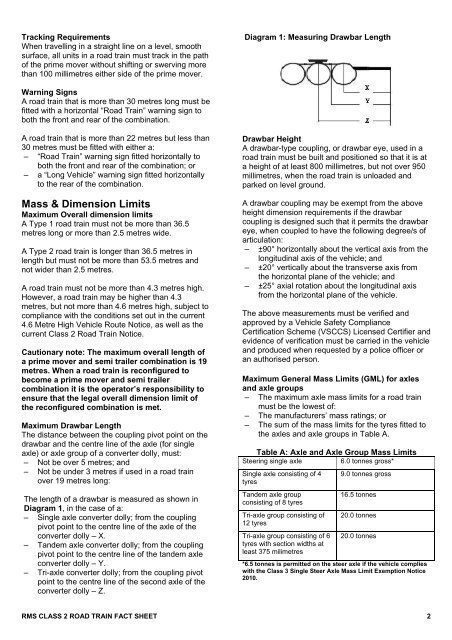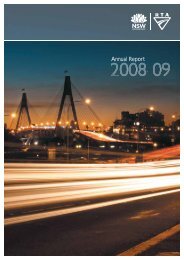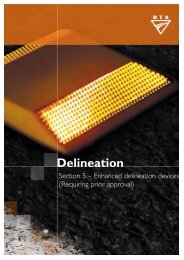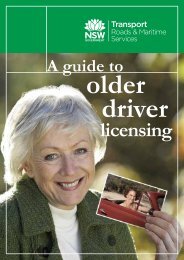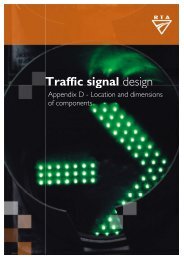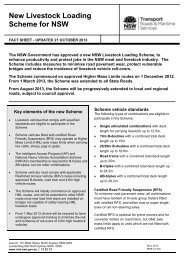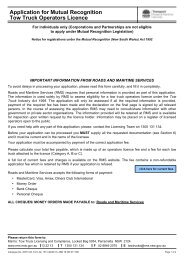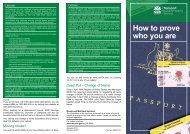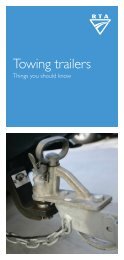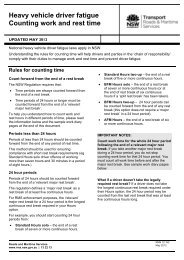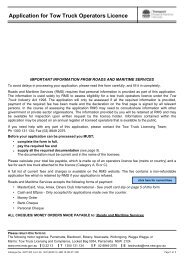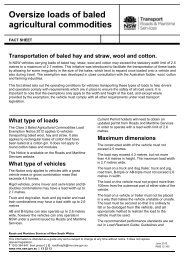Class 2 road trains fact sheet - RTA - NSW Government
Class 2 road trains fact sheet - RTA - NSW Government
Class 2 road trains fact sheet - RTA - NSW Government
Create successful ePaper yourself
Turn your PDF publications into a flip-book with our unique Google optimized e-Paper software.
Tracking Requirements<br />
When travelling in a straight line on a level, smooth<br />
surface, all units in a <strong>road</strong> train must track in the path<br />
of the prime mover without shifting or swerving more<br />
than 100 millimetres either side of the prime mover.<br />
Diagram 1: Measuring Drawbar Length<br />
Warning Signs<br />
A <strong>road</strong> train that is more than 30 metres long must be<br />
fitted with a horizontal “Road Train” warning sign to<br />
both the front and rear of the combination.<br />
A <strong>road</strong> train that is more than 22 metres but less than<br />
30 metres must be fitted with either a:<br />
– “Road Train” warning sign fitted horizontally to<br />
both the front and rear of the combination; or<br />
– a “Long Vehicle” warning sign fitted horizontally<br />
to the rear of the combination.<br />
Mass & Dimension Limits<br />
Maximum Overall dimension limits<br />
A Type 1 <strong>road</strong> train must not be more than 36.5<br />
metres long or more than 2.5 metres wide.<br />
A Type 2 <strong>road</strong> train is longer than 36.5 metres in<br />
length but must not be more than 53.5 metres and<br />
not wider than 2.5 metres.<br />
A <strong>road</strong> train must not be more than 4.3 metres high.<br />
However, a <strong>road</strong> train may be higher than 4.3<br />
metres, but not more than 4.6 metres high, subject to<br />
compliance with the conditions set out in the current<br />
4.6 Metre High Vehicle Route Notice, as well as the<br />
current <strong>Class</strong> 2 Road Train Notice.<br />
Cautionary note: The maximum overall length of<br />
a prime mover and semi trailer combination is 19<br />
metres. When a <strong>road</strong> train is reconfigured to<br />
become a prime mover and semi trailer<br />
combination it is the operator’s responsibility to<br />
ensure that the legal overall dimension limit of<br />
the reconfigured combination is met.<br />
Maximum Drawbar Length<br />
The distance between the coupling pivot point on the<br />
drawbar and the centre line of the axle (for single<br />
axle) or axle group of a converter dolly, must:<br />
– Not be over 5 metres; and<br />
– Not be under 3 metres if used in a <strong>road</strong> train<br />
over 19 metres long:<br />
The length of a drawbar is measured as shown in<br />
Diagram 1, in the case of a:<br />
– Single axle converter dolly; from the coupling<br />
pivot point to the centre line of the axle of the<br />
converter dolly – X.<br />
– Tandem axle converter dolly; from the coupling<br />
pivot point to the centre line of the tandem axle<br />
converter dolly – Y.<br />
– Tri-axle converter dolly; from the coupling pivot<br />
point to the centre line of the second axle of the<br />
converter dolly – Z.<br />
Drawbar Height<br />
A drawbar-type coupling, or drawbar eye, used in a<br />
<strong>road</strong> train must be built and positioned so that it is at<br />
a height of at least 800 millimetres, but not over 950<br />
millimetres, when the <strong>road</strong> train is unloaded and<br />
parked on level ground.<br />
A drawbar coupling may be exempt from the above<br />
height dimension requirements if the drawbar<br />
coupling is designed such that it permits the drawbar<br />
eye, when coupled to have the following degree/s of<br />
articulation:<br />
– ±90° horizontally about the vertical axis from the<br />
longitudinal axis of the vehicle; and<br />
– ±20° vertically about the transverse axis from<br />
the horizontal plane of the vehicle; and<br />
– ±25° axial rotation about the longitudinal axis<br />
from the horizontal plane of the vehicle.<br />
The above measurements must be verified and<br />
approved by a Vehicle Safety Compliance<br />
Certification Scheme (VSCCS) Licensed Certifier and<br />
evidence of verification must be carried in the vehicle<br />
and produced when requested by a police officer or<br />
an authorised person.<br />
Maximum General Mass Limits (GML) for axles<br />
and axle groups<br />
– The maximum axle mass limits for a <strong>road</strong> train<br />
must be the lowest of:<br />
– The manu<strong>fact</strong>urers’ mass ratings; or<br />
– The sum of the mass limits for the tyres fitted to<br />
the axles and axle groups in Table A.<br />
Table A: Axle and Axle Group Mass Limits<br />
Steering single axle<br />
6.0 tonnes gross*<br />
Single axle consisting of 4<br />
tyres<br />
Tandem axle group<br />
consisting of 8 tyres<br />
Tri-axle group consisting of<br />
12 tyres<br />
Tri-axle group consisting of 6<br />
tyres with section widths at<br />
least 375 milimetres<br />
9.0 tonnes gross<br />
16.5 tonnes<br />
20.0 tonnes<br />
20.0 tonnes<br />
*6.5 tonnes is permitted on the steer axle if the vehicle complies<br />
with the <strong>Class</strong> 3 Single Steer Axle Mass Limit Exemption Notice<br />
2010.<br />
RMS CLASS 2 ROAD TRAIN FACT SHEET 2


